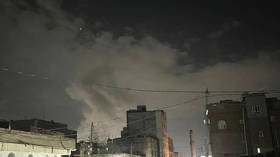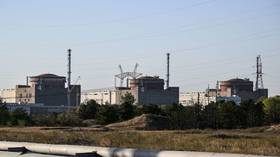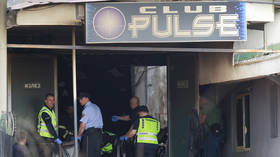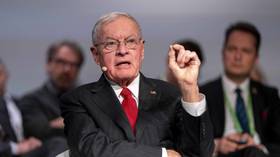Year of discontent: Biggest US protests of 2016
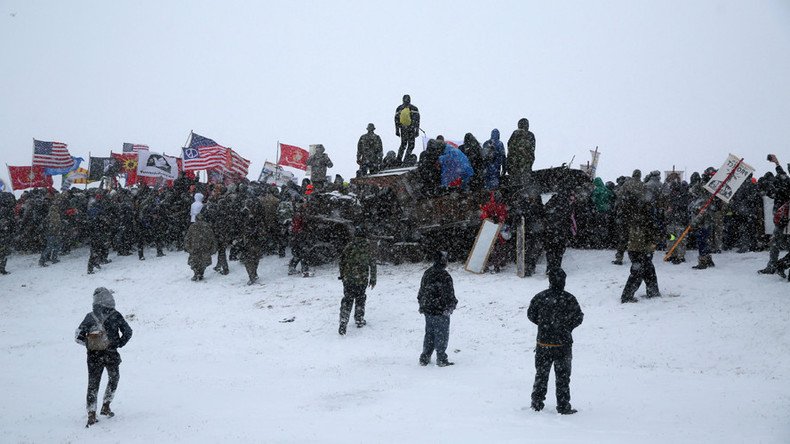
Hardly a week went by in the presidential election year without a protest in the US expressing discontent with candidates, frustration over low-paying jobs or outrage over police brutality.
Anger was also expressed over the government’s handling of land manifested in the occupation of an Oregon refuge and North Dakota pipeline standoffs.
Protests against police brutality
The year opened with a Black Lives Matter march and protest over the shooting death of African American Mario Woods during the mayor’s inauguration at San Francisco’s City Hall. Police said Woods, who was killed the month before, had a knife which he refused to drop. Woods being shot 20 times was caught on graphic video.
While the early part of the year wasn’t without confrontation between residents and police, it wasn’t until the month of July when a sequence of back-to-back killings by police, some recorded on cell phones, sparked massive protests over police brutality. As it was with Ferguson, the protests lifted the lid on entrenched poverty, tense relationships with police in cities not often in news headlines from Boca Raton to St. Anthony’s to Charlotte.
On July 5, police shot Alton Sterling at point blank range while pinned to the ground by two white Baton Rouge police officers and on July 6 Philando Castile was shot in his car outside of Minneapolis, Minnesota, with the incident broadcast via Facebook live by his girlfriend.
On July 7, during a peaceful protest at Dallas, Texas army veteran Micah Xavier Johnson opened fire in an ambush and killed five police officers and wounded seven others and two civilians. According to police, “he was upset about Black Lives Matter,” and “he wanted to kill white people, especially white officers.”
#Dallas police officers and civilians run for cover from sniper as fifth officer dies [VIDEO] https://t.co/BNuDo1DKP0
— RT America (@RT_America) July 8, 2016
Rallies and escalated into nationwide protests in a few days. On July 9, a protest in Baton Rouge turned violent, with one police officer having several teeth knocked out and eight firearms (including three rifles, three shotguns, and two pistols) being confiscated from New Black Panther Party members. Police arrested 30 people over several days. In a companion protest in Rochester, New York, over 74 people were arrested.
Image of unarmed black woman in flowing dress facing police at #BlackLivesMatter rally in Louisiana goes viral https://t.co/kmLbPzIVCm
— RT (@RT_com) July 11, 2016
Some 102 people were arrested and 21 police offers were injured in St. Paul, Minnesota on July 10. A group threw rocks, bottles, and Molotov cocktails at police and police responded with pepper spray and tear gas.
Ten days after the Dallas attack, a man wearing a ski mask and armed with two rifles and a pistol killed three officers near a gas station and convenience store in Baton Rouge.
BREAKING: The slain Baton Rouge officers were intentionally targeted. FOLLOW LIVE UPDATES: https://t.co/XCgU6XiGaXpic.twitter.com/WxLIn8tnkV
— RT America (@RT_America) July 18, 2016
In September 2016, protests against the shooting death by police officers of Keith Lamont Scott in Charlotte, North Carolina turned violent and lasted for six days. On the second night, protests became violent with windows broken and looted. One protester was killed, dozens were injured and 44 were arrested. City leaders ordered a curfew.
From Flint to Standing Rock: Rallying for the environment
The year began with Michigan Governor Rick Snyder declaring an emergency for Genesee County over the contamination of Flint’s water supply that was caused by the city authorities’ desire to save money, negligence and cover-ups.
It took almost a year before city and state leaders acted, despite a public outcry and protests.
By year’s end, the state’s attorney general had filed criminal charges against nine people involved in the scandal and uncovered a conspiracy. Some charges carry penalties of up to 20 years in prison.
In April, LaDonna Brave Bull Allard, an elder member of the Standing Rock Sioux Tribe, established the Sacred Stone Camp to protest the Dakota Access Pipeline running under the Missouri River. The DAPL is a crude oil pipeline due to be built through four states to transport oil from the Bakken oil fields to Illinois.
The Standing Rock Sioux believe the pipeline would put the Missouri River, the water source for the reservation, at risk. They point out two recent spills, a 2010 pipeline spill into the Kalamazoo River in Michigan, which cost over $1 billion to clean up with significant contamination remaining, and a 2015 Bakken crude oil spill into the Yellowstone River in Montana. The tribe is also concerned that the pipeline route may run through sacred Sioux sites.
The Standing Rock Sioux filed an injunction against the Army Corps of Engineers to stop building the pipeline on April 21.
Protests at the camp site began in spring 2016 and drew indigenous people and other supporters from across North America, growing to as many as 4,000 people camped at the site. In August 2016 protests were held, halting a portion of the pipeline near Cannon Ball, North Dakota. A number of planned arrests occurred when people chained themselves to heavy machinery.
As the numbers grew beyond what Allard's land could support, an overflow camp was also established nearby.
Protests began intensifying following the pipeline’s official approval on August 3. On August 10, the Standing Rock Sioux Tribe requested a preliminary injunction to halt pipeline construction as they appealled the permits given to developers. Their injunction claims that the US Army Corps of Engineers, “has taken actions in violation of multiple federal statutes that authorize the pipeline.”
The injunction also claims that the Dakota Access Pipeline (DAPL) may have gotten ahead of itself, saying: “DAPL has initiated construction even though the regulatory process remains incomplete, numerous lawsuits have been filed against it, and significant public controversy surrounds the project.”
On August 12, a dozen people were arrested for encroaching on a zone established for workers’ safety. Among the charges were disorderly conduct and criminal trespassing. One of the arrested was a leader of the Standing Rock Sioux Nation, Tribal Chairman David Archambault II.
Facebook ‘censors’ Dakota Access pipeline protest livestream – activistshttps://t.co/SaZ7gtfEfrpic.twitter.com/j3f33eGiV4
— RT America (@RT_America) September 15, 2016
On August 20, construction of the Dakota Access Pipeline was halted due to pending court cases. The pipeline, seen by many as Keystone XL Pipeline Round Two, received permission from all the four states it crosses to begin construction, despite the risks posed to citizens.
On August 23, Standing Rock Sioux Tribe released a list of 87 tribal governments who wrote resolutions, proclamations and letters of support stating their solidarity with Standing Rock and the Sioux people.
On August 24, Standing Rock Sioux Tribe members attended a hearing at US District Court in Washington, DC. Outside the court house, they held a protest joined by actresses Riley Keough, Susan Sarandon and Shailene Woodley, as well as Josh Fox, director of Gasland, the award-winning documentary about the consequences of fracking.
LIVE on #Periscope: Live from #NODAPL protest in Washington DC #StandingRockSioux#DakotaAccessPipelinehttps://t.co/SWaugwS1Ry
— Alexey Yaroshevsky (@Yaro_RT) August 24, 2016
The same day, with temperatures around 90 degrees, North Dakota authorities removed drinking water tanks from a camp central to protests over the Dakota Access Pipeline. The items had been delivered a week prior by the state Department of Health at the request of the Standing Rock Sioux Tribe.
On September 1, more than 100 people protested in Boone, Iowa, at four entrances to a construction staging site for the pipeline in solidarity with the protesters in North Dakota. As protesters chanted, “This is what democracy looks like,” police made 30 arrests, among them Crystal Defatte, a stay-at-home mother with three children.
"Every year you hear about oil spills. I don't want oil in the water that my children drink. This is a moral responsibility for me," Defatte told the Des Moines Register.
In September, Allard said that “380 archaeological sites faced desecration along the entire pipeline route, from North Dakota to Illinois, 26 of them are right here at the confluence of these two rivers. It is a historic trading ground, a place held sacred not only by the Sioux Nations, but also the Arikara, the Mandan, and the Northern Cheyenne.”
On September 3, DAPL brought in a private security firm as they used bulldozers to dig up part of the pipeline route that was subject to a pending injunction motion and dug up Native graves and burial artifacts. When unarmed protesters moved near bulldozers, the guards used pepper spray and guard dogs to protect the site. At least six protesters were treated for dog bites, and an estimated 30 protesters were pepper-sprayed before the security guards and their dogs exited the scene.
Protests, escalating in intensity and injury and arrests, continued over the next few months.
MORE: Police use rubber bullets, mace at Dakota Access Pipeline protesters, 1 person being rushed to clinic - report https://t.co/338cmAW24Q
— RT America (@RT_America) November 2, 2016
Until on December 4, the Army Corps of Engineers announced it would not permit an easement through federal lands and would temporary halt the construction of the pipeline to allow an environmental impact review.
Election
Election year saw clashes not only at candidates debates, but outside among their supporters and opponents. The events with future President-elect Donald Trump attracted the most action.
At a campaign rally in New Orleans on March 5, Donald Trump’s security clashed with pockets of angry protesters among the crowd. Normally loquacious about his own achievements, the candidate struggled to speak before becoming irate and instructing his team, “Get out of here! Get them out of here! Get out of here. Real trouble makers.”
In April, there were a week of protests involving marches and sit-ins in Washington DC called Democracy Spring. At least 400 people were arrested for staging sit-ins. Their demands centered on creating fairer elections and politics that are unmarred by corporations' big bucks.
Nevada’s Democratic party convention turned into “an unruly and unpredictable event” on May 17 when Sanders supporters protested convention rules that ultimately lead to Hillary Clinton winning more pledged delegates. Clinton supporters claimed that Sanders supporters threw chairs, shouted down speakers and later allegedly harassed the state party chair Roberta Lange with death-threat phone calls. Sanders’ campaign vigorously denied the allegations.
Sanders delegates boo Clinton mentions as DNC seeks to show unified party https://t.co/9Xy5vfNBCTpic.twitter.com/gHpqYERnEM
— RT America (@RT_America) July 25, 2016
At the opening of the Republican National Convention on July 18, with Donald Trump as the potential Republican nominee, hundreds of demonstrators marched against racism and police brutality in downtown Cleveland on Sunday, where the Republican National Convention was set to kick off.
‘Every American citizen’s right’: Armed men parade outside GOP convention (VIDEO) https://t.co/1GlJhyLonrpic.twitter.com/njV7k6IRkK
— RT America (@RT_America) July 19, 2016
Despite Democratic candidate Hillary Clinton winning a majority of the party’s internal primaries and caucuses, she didn’t get much public support at the Democratic National Convention in Philadelphia, Pennsylvania.
With temperatures in the mid-90s, dozens of protesters were detained in Philadelphia at the beginning of the Democratic National Convention on July 25 as thousands rallied against Hillary Clinton’s official nomination.
Protesters also staged a sit-in to block delegates from entering the Wells Fargo Center, where the Convention was being held, chanting “Hell no, DNC, we won’t vote for Hillary,” as anti-Clinton banners flooded the streets outside the center.
Demonstrators outside City Hall chanted, “Nominate Sanders or lose in November!”
In the end, 55 people were issued citations for disorderly conduct for trying to climb over police barricades at the edge of the security zone surrounding the convention, law enforcements said, according to AP.
Local police braced for the up to 50,000 protesters that were expected daily.
At the California delegation breakfast on Monday morning, Sanders supporters chanted his name and booed any mentions of presumptive Democratic nominee Hillary Clinton.
However, as tensions at the protest ran high, Sanders urged his supporters to stop chanting, “Lock her up,” a chant that originated among Trump supporters who want Hillary Clinton to face prison time for alleged crimes.
“Make no mistake. We have made history,” Sanders reportedly told the crowd, stressing that the Democratic Party itself would lose without Clinton’s victory.
At the opening of the Republican National Convention on July 18, hundreds of demonstrators marched against racism and police brutality in downtown Cleveland on Sunday, where the Republican National Convention was set to kick off.
The day after Trump’s win in the November general election, protests began outside Trump Tower in New York with the chant “Not my president!” and were followed by weeks of protests in major cities. Unusually, it was also schoolchildren in their hundreds who went on mass protests in Los Angeles, Portland and New York.
#Phoenix high-school students stage anti-Trump #walkout on #ElectionDayhttps://t.co/VnelueKumypic.twitter.com/UtcJel3Scl
— RT America (@RT_America) November 8, 2016
On the day of the Electoral College vote on December 19, in major cities across the US people protested the vote, challenging Trump electors to reverse their vote.
‘Not my president!’ Anti-Trump protesters take to streets nationwide, dozens arrested https://t.co/m6WEyLVN08pic.twitter.com/5e3WkYySog
— RT America (@RT_America) November 10, 2016
Labor woes: From Fight for $15 to TPP
The ‘Fight for $15,’ a movement demanding an increase in the minimum wage to $15 an hour, carried out a number of protests during the year, mostly targeting fast food workers at McDonalds.
The movement has union backing from the Service Employees International Union, an initiative that was begun in 2012. The effort has been effective in persuading lawmakers at the state and city level to pass legislation to increase the minimum wage in incremental amounts, while the federal minimum wage remains at $7.25.
The protest has been expanded beyond fast food workers to include airport workers, home care and healthcare workers.
#NoPayNoWork: Detroit teachers' 'sickout' closes majority of public schools https://t.co/Fap2yC11Mlpic.twitter.com/hc0zxYHqwz
— RT America (@RT_America) May 2, 2016
Opposition to TPP grows as postal workers’ union rallies against deal https://t.co/4FJlrpjOmy
— RT America (@RT_America) August 25, 2016
‘All we’re asking for is what’s fair’: Teamsters strike at #UCLAhttps://t.co/PpAs3VHTh5pic.twitter.com/WwXwqsrtlg
— RT America (@RT_America) November 17, 2016
Minimum wage increases became a hot issue on the ballot in the election year.
Prison Protest
More than 24,000 inmates in at least 40 prisons from over two dozen states refused to follow orders, failing to report for work and causing prisons to go on lockdown, since the nationwide prison work strike began in early September.
From Alabama to Michigan to Texas, despite the isolation of prisons and a desire to cover-up news of the work stoppages by correctional departments, reports are leaking of widespread disruption at prisons.
The nationwide prison strike began September 9, when inmates refused to report for their prison jobs. It became the largest prison strike in US history.
READ MORE: Prison inmates stage nationwide protest marking 45 years after Attica
The nationwide strike also marked the 45th anniversary of the 1971 Attica Prison riot, when 1,300 men demanded an end to slave labor, an end to law enforcement brutality and fair visitation rights. The strike lasted four days before law enforcement raided the prison, killing 39 inmates and guards, leaving 128 men injured. Afterward, prisoners who survived the shooting were then tortured.
Land Rights
A standoff began on January 2 at Oregon Malheur National Wildlife Refuge as a protest against the federal government’s treatment of two local ranchers, Dwight and Steven Hammond.
A dozen or so armed ranchers and self-styled militiamen, calling themselves Citizens for Constitutional Freedom, took over the refuge and renamed it Harney County Resource Center.
Armed militiamen in fourth day of Oregon federal refuge occupation [VIDEO] https://t.co/9RXH6spuKy@egorpiskunov_RTpic.twitter.com/obXPW39LOD
— RT America (@RT_America) January 6, 2016
The group was led by Ammon and Ryan Bundy, sons of the Nevada rancher Cliven Bundy, who successfully challenged the Bureau of Land Management in 2014 in a dispute over grazing rights. The Bundy brothers called on the federal government to cede the lands around Lake Malheur to the local ranchers and argued their actions were in line with the US Constitution.
After keeping a low profile for several weeks, the authorities escalated their response on January 27, arresting the Bundy brothers and five other supporters and charging them with conspiracy to interfere with federal officials. The occupiers’ spokesman, Robert “LaVoy” Finicum, was fatally shot by Oregon State Police at a roadblock.
READ MORE: FBI releases video of shooting death of Oregon refuge protester
More than two dozen militants were charged with federal offenses, including conspiracy to obstruct federal officers, firearms violations, theft, and depredation of federal property.
Many pleaded guilty, while others, including Ammon and Ryan Bundy, have been tried and acquitted of all federal charges.




